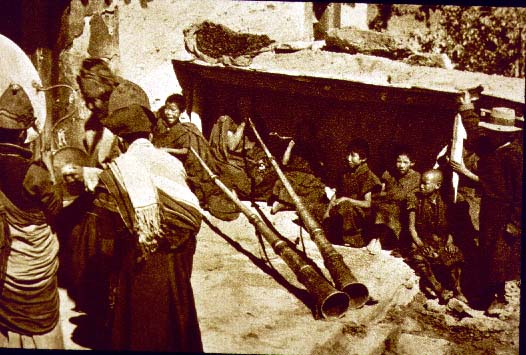
Three Ngakpas
Practice at a typical small Nyingma Gompa
This delightful scene is characteristic of many of the small Nyingma gompas which used to exist in Tibet. From the time of King Ralpachen the red and white sanghas have always practised together in harmony. These three unknown ngakpas are playing nga-chen (nga chen – large drum); rolmo (rol mo – wrathful cymbals); and sil-nyen (sil sNyan – peaceful cymbals). They are wearing the Dorje Zahorma hats of Nyingma Lamas, and the red, white, and blue striped shawls of the gö-kar-chang-lo’idé (gos dKar lCang lo’i sDe). Two of the ngakpas are wearing maroon chubas and one (far left) is wearing a white shamthab – the white yogic skirt of the white sangha. The monks in the courtyard are playing dung chen (dung chen – great horn or rag dung – brass horn). Far right stands a lay man who has come to take part in the proceedings.
Ngakma Shardröl points out:
It should be noted that the word ‘lay’ only applies to non ordained. Ngakpas and ngakmas are not ‘lay people’. The word ‘lay’ has become misused in the West amongst adherents of predominantly celibate traditions to indicate ‘non-celibate’. To use the word ‘lay’ of the ordained non-celibate sangha of the Nyingma tradition is inappropriate. The Shorter Oxford dictionary definition of the word ‘lay’ is: A person who is not a cleric; a member of the laity. A person without professional or special knowledge in a particular subject, esp. law or medicine. Various writers have described HH Dudjom Rinpoche as ‘a lay Buddhist Master’, assuming that ‘lay’ simply meant non-celibate – but we have not found either a US or UK English dictionary which has agreed with this usage of the word. Dictionaries of other languages also agree: German, Dutch, Swedish, French, Spanish, Italian, Norwegian, Danish, and Finnish.
